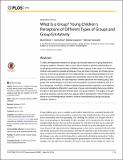What is a group? Young children's perceptions of different types of groups and group entitativity
Date
24/03/2016Metadata
Show full item recordAbstract
To date, developmental research on groups has focused mainly on in-group biases and intergroup relations. However, little is known about children’s general understanding of social groups and their perceptions of different forms of group. In this study, 5- to 6-year-old children were asked to evaluate prototypes of four key types of groups: an intimacy group (friends), a task group (people who are collaborating), a social category (people who look alike), and a loose association (people who coincidently meet at a tram stop). In line with previous work with adults, the vast majority of children perceived the intimacy group, task group, and social category, but not the loose association, to possess entitativity, that is, to be a ‘real group.’ In addition, children evaluated group member properties, social relations, and social obligations differently in each type of group, demonstrating that young children are able to distinguish between different types of in-group relations. The origins of the general group typology used by adults thus appear early in development. These findings contribute to our knowledge about children's intuitive understanding of groups and group members' behavior.
Citation
Plötner , M , Over , H , Carpenter , M & Tomasello , M 2016 , ' What is a group? Young children's perceptions of different types of groups and group entitativity ' , PLoS ONE , vol. 11 , no. 3 , e0152001 . https://doi.org/10.1371/journal.pone.0152001
Publication
PLoS ONE
Status
Peer reviewed
ISSN
1932-6203Type
Journal article
Rights
© 2016 Plötner et al. This is an open access article distributed under the terms of the Creative Commons Attribution License, which permits unrestricted use, distribution, and reproduction in any medium, provided the original author and source are credited.
Description
The authors thank the ESRC for supporting H. Over (grant number ES/K006702/1)Collections
Items in the St Andrews Research Repository are protected by copyright, with all rights reserved, unless otherwise indicated.

